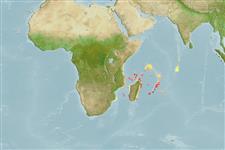Teleostei (teleosts) >
Centrarchiformes (Basses) >
Kuhliidae (Aholeholes)
Etymology: Kuhlia: Because of Heindrich Kuhl, 1797-1821; researcher also with lizards (Gekkonidae).
More on author: Lacepède.
Environment: milieu / climate zone / depth range / distribution range
Ecology
Marine; freshwater; brackish; benthopelagic. Tropical (Ref. 6799)
Africa: probably known only from Reunion, Mauritius, Rodriguez and Madagascar (Ref. 57749).
Size / Weight / Age
Maturity: Lm ? range ? - ? cm
Max length : 25.0 cm TL male/unsexed; (Ref. 6799)
Short description
Identification keys | Morphology | Morphometrics
Dorsal spines (total): 10; Dorsal soft rays (total): 11 - 14; Anal spines: 3; Anal soft rays: 11 - 13. Oval and high body, laterally compressed and elongated. Lower jaws proeminent. Large protusible and superior mouth. Opercle shows two spines. Dorsal fin starts at the same level than the pelvics. Silvery body with a darker blue to greyish back. Caudal forked with two vertical stripes. First at the base of the caudal and second is the posterior margin of the fin. In between these two stripes is a white stripe. K. splendens Regan, 1913 might be a synonym of that species (Stapley pers. com.).
Life cycle and mating behavior
Maturities | Reproduction | Spawnings | Egg(s) | Fecundities | Larvae
Keith, P., G. Marquet, P. Valade, P. Bosc and E. Vigneux, 2006. Atlas des poissons et des crustacés d'eau douce des Comores, Mascareignes et Seychelles. Muséum national d’Histoire naturelle, Paris. Patrimoines naturels, 65:250p. (Ref. 57749)
IUCN Red List Status (Ref. 130435)
Threat to humans
Harmless
Human uses
Tools
Special reports
Download XML
Internet sources
Estimates based on models
Preferred temperature (Ref.
123201): 25.4 - 28, mean 27.2 °C (based on 153 cells).
Phylogenetic diversity index (Ref.
82804): PD
50 = 0.5002 [Uniqueness, from 0.5 = low to 2.0 = high].
Bayesian length-weight: a=0.01413 (0.00591 - 0.03375), b=3.06 (2.86 - 3.26), in cm total length, based on LWR estimates for this (Sub)family-body shape (Ref.
93245).
Trophic level (Ref.
69278): 3.4 ±0.5 se; based on size and trophs of closest relatives
Resilience (Ref.
120179): Medium, minimum population doubling time 1.4 - 4.4 years (Preliminary K or Fecundity.).
Fishing Vulnerability (Ref.
59153): Low vulnerability (15 of 100).
